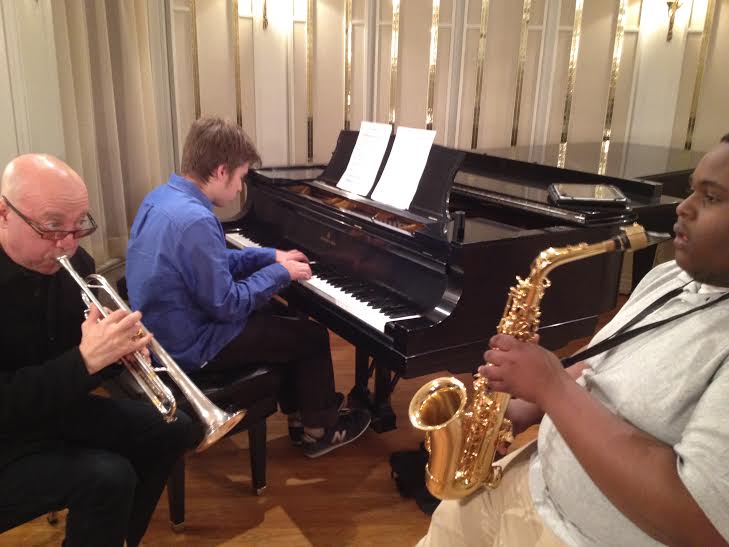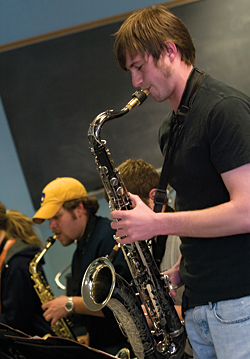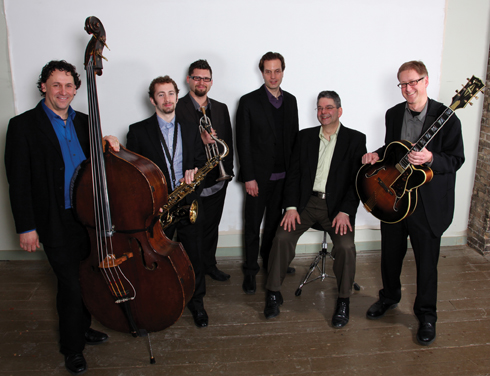
Artist-in-residence and Grammy-winning trumpeter Brian Lynch (left) works with the Wisconsin Conservatory Music Jazz Institute’s award-winning students saxophonist Lenard Simpson and student pianist Peter Garofalo.
Jazz ain’t the music that made Milwaukee famous. However, like beer, the music’s innate effervescence is part of this city’s cultural DNA. Improv and swing are rising locally, and reflect the creative brewing of musicians – like sax and brass players – who literally blow life into their instruments.
I’ve been extremely impressed by the young-musician generation since returning to Milwaukee, two decades after extensively covering the jazz scene here.
“A difference today is a very strong crop of young players in town,” says trumpeter Jamie Breiwick.
For a serious art form, jazz education is essential for performers and to cultivate audiences, unlike more innately popular folk- or mass media-based arts. Education creates musician’s work, as it has for decades with an art form that commingles sophistication and soulful grittiness. Down Beat magazine extensive annual October jazz education guide provides a documentation of the art form’s ongoing growth at the roots of youth nationwide, and is considered so important that Jazz Times has begun offering an annual jazz guide as well.

UW-Milwaukee offers a bachelor’s degree in jazz studies, begun in 1990. Photo courtesy of The Peck School of the Arts.
UW-Milwaukee’s jazz studies degree program, begun in the wake of the city’s 1980s jazz revival, is directed by noted veteran reed player Curt Hanrahan, and signifies the music’s growth and demand, as does the ambitious Jazz Institute at the Wisconsin Conservatory of Music, which holds concerts, summer camps and annual residencies by Milwaukee-born trumpeter Brian Lynch, a Grammy-winning former Jazz Messenger with Art Blakey. Plus, The West End Conservatory opened on Vliet Street a few years ago with a strong faculty of young professional jazz musicians.
A highlight of the jazz education year will be the second annual Music Education Day at Summerfest on Wednesday, September 17 (with a free lunch) featuring nationally known clinicians, including New Orleans drummer-bandleader Adonis Rose, who leads his own quintet and has worked with Wynton Marsalis, Terence Blanchard, Nicholas Payton and other jazz luminaries. Jazz Institute director Mark Davis will also lead a group. Last year’s event drew 600 school-age music students.
The Conservatory’s accredited jazz degree program, launched in 1971, crucially sparked that era’s early 1980’s jazz renaissance. The Jazz Institute, underwritten by the Batterman Foundation, also selects top high school players for scholarships in private lessons, theory classes and concerts. In addition to the Prospect Avenue Conservatory home, The Institute now also has branch locations in Fox Point and Brookfield.
For the third consecutive year, the program’s Batterman Ensemble placed as a finalist in the International Charles Mingus Jazz Competition, and in 2013 won the competition’s “Mingus Spirit” award and the group’s trumpeter Travis Drow won an outstanding soloist award. The current ensemble took first place for best high school ensemble in 2014 at the Eau Claire Jazz Festival. In 2012, the Batterman’s 17-year-old saxophonist Lenard Simpson won the Mingus event’s “outstanding soloist.”

The Jazz Institute’s Batterman Ensemble recently won the award for best jazz high school Jazz Ensemble at the Eau Claire Jazz Festival. The ensemble includes (L-R) Jordan Rattner on guitar, Gervis Myles on bass, Amy Clapp on tenor sax, Hannah Johnson on drums and Travis Drow on trumpet.
This sounds like a dynamic art form in town, yet an old saw endures: “Jazz is dying.” “Compared to what? For the last story about that, we had a joke: All the jazz musicians were unavailable for comment,” responds the Conservatory’s pianist Davis.
“All the musicians I know are constantly working,” concurs Breiwick, also a professor at the UWM program.
“You really need to work at it, but it pays off,” adds Jeff Hamann, the city’s “first-call” bassist, a Conservatory instructor and house bassist in Michael Feldman’s nationally-syndicated radio program “Whad D’ya Know?” “My peers seem to keep busy.” However, Hamann has noticed less work for some veteran players. “Everyone’s path to success is a little different.”
“The value of jazz education is that you can play just about any type of music with it,” Davis says. And yet, he adds, “some music programs are dwindling, especially in the inner city.” But WCM and other higher-ed programs provide scholarships — and the Conservatory faculty ensemble, We Six, does residencies and performances — at these schools.
“Milwaukee seems on a real upswing, with numerous incredible Conservatory-trained high school and college players coming up: Lenard Simpson, trumpeter Alec Aldred, guitarist Tommy Antonic, saxophonist Robert Larry (from UWM) and percussionist Jake Richter — now on full scholarship to Indiana University.”
“Their success comes from education, the jazz community and musicians acting as mentors, if only through their playing. Guys like Jamie Breiwick. Last night, Jordan Rattner, a great high school guitarist and trumpeter Cody Longreen sat in with us. You can’t just teach jazz in classroom. You gotta be out in the real world,” Davis says.
“You hear criticisms that academia creates musical clones, who all sound the same. I think it’s a reaction to more jazz education and less playing opportunities.”
Jazz still fights against American anti-intellectualism, and it lacks the funding base classical music enjoys. Yet jazz persists.
“You have to learn how to hear those harmonies to really understand it,” Davis concludes. “Most jazz musicians recognize the need to give something back, to educate people to create an audience for tomorrow. Most people I taught 20 years ago are adults and hopefully it’s part of their culture.”

The 2014-15 We Six concert season will honor the passing of the great hard-bop pianist, composer and bandleader Horace Silver, as well as a concert that will reproduce all the music from Wayne Shorter’s 1964 Blue Note album Speak No Evil, one the most brilliant and influential recordings of modern jazz. This season also includes a concert of original compositions by the ensemble’s members.
The Music of Horace Silver — October 9, 2014. We Six performs “Nica’s Dream,” “Strollin’,” “
“Speak No Evil” — November 13, 2014. To commemorate the 50th anniversary of Wayne Shorter’s iconic album Speak No Evil, We Six performs “Witch Hunt,” “Fee-Fi-Fo-Fum,” “
All Our Own — March 19, 2015. An annual showcase, this concert features new original compositions and arrangements by members of We Six.
Sounds of Brazil — April 16, 2015. We Six draws upon the musical traditions of Brazil, performing works by Antonio Carlos Jobim, Ivan Lins, Luiz Bonfá, and others.
______________
Unless otherwise noted, all photos are courtesy of the Wisconsin Conservatory of Music Jazz Institute.
A shorter version of this article was published in The Shepherd Express.


Where are the African American students and faculty ? Nothing has changed at all I’m sorry to say .
Gerald Cannon,
Just caught up with your comment. I imagine you are commenting on the Conservatory demographic. I can’t speak for the racial make-up of students or faculty, except to note that the student saxophonist most noted and awarded recently is black alto man Lenard Simpson, pictured with Brian Lynch at top. In the two pix from the Conservatory, two of the seven students are African American or 35 per cent, which is higher than the city’s Af-Am representation in city population — as it should be for a jazz program. But you may finally have a strong point. Thanks for commenting.